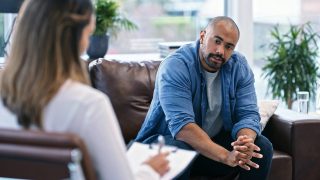
What is the difference between cover and concealment? For most, the answer is simple. Cover will stop a projectile, provide protection and hide your position. On the other hand, concealment provides no protection but will hide your position. But is the answer that simple? Maybe a better question to ask is how an officer knows an object will actually stop a projectile. As some of us have learned the hard way, that question can only be answered when the bullets start flying and your life — and the lives of others — are hanging in the balance.
After leaving the Marine Corps in 2015, I developed a course for law enforcement and medical personnel called the High Threat Ballistics Lab. Drawing on lessons learned overseas, I wanted first responders to understand the multiple variables that determine whether or not an object will provide sustainable cover. We achieve this goal by first identifying the four principles of cover: material, weapon, ammunition and position. We then demonstrate these principles in action by shooting multiple objects, including cinder blocks, door frames, windshields, car doors and other parts of vehicles, from varying distances and angles. Finally, students examine the objects and discuss the implications when responding to high-threat calls. Here are our observations after running hundreds of officers and medical first responders through the High Threat Ballistics Lab.
Cover will stop a projectile, provide protection and hide your position. On the other hand, concealment provides no protection but will hide your position.
Material
The first principle of cover is material. The two primary considerations for material are exterior and interior. The material’s exterior is what we observe it to be (e.g., brick, metal and wood). This, along with the size of the cover, are our primary determination on whether or not an object will provide adequate cover. However, one consideration we often don’t make when examining the exterior of cover is the possibility of the object fragmenting, thereby creating flak or shrapnel. This is best demonstrated when shooting a door. Surprisingly, a standard door frame will hold up against most rounds. However, when the edge is shot, wood splinters are sent flying. These tiny projectiles, like fragments from most other objects, have the potential to take an officer out of the fight just as easily as a direct hit.
The interior material of an object is largely unknown. The best demonstration of this concept is shooting cinder blocks, some unfilled and others filled with cement or sand. While some cinder blocks fair better than others, this exercise exposes one of the biggest takeaways from the course — cover is consumable! Most objects will not provide sustainable cover, and some objects can only take a few impacts before deteriorating completely.
Weapon
The second principle of cover is the weapon. The type of weapon or firearm used will also determine how effective an object will be at providing cover. Handguns, rifles and shotguns all pack a different punch, with nearly endless variants within each category. Another consideration is the distance at which the firearm is being fired in relation to the piece of cover. An officer will likely not know the specific firearm being used by a suspect. However, understanding this principle can help them in selecting a piece of cover based on the firearm type and distance.
Ammunition
In direct relation to the type of firearm, principle three is the type of ammunition used by the assailant. Ammunition plays a significant role in the sustainability of cover. There is a reason AR500 steel targets can’t be shot with steel core rounds. However, penetration is only one part of the conversation. Remember, cover is consumable. While certain types of ammunition may penetrate an object more effectively, other types of ammunition can create more fragments, creating other challenges during a gun fight. During the fight, officers won’t know the exact ammunition a suspect is using. However, if an officer starts seeing holes in what was presumably a solid piece of steel or masonry, that might be a clue of the type of threat the officer is up against.

Position
The fourth principle of cover is the position of the threat in terms of distance and elevation. When asking officers what part of a vehicle can be used for cover, the engine block is always the first answer. While this answer isn’t wrong, it’s not universally true. Examining the first principle of cover reminds us the interior of an object is equally, if not more important than the exterior. Between the engine block and hood of every car is a gap that provides no protection. This can be demonstrated by shooting the hood from the kneeling position. At this angle, most rounds penetrate the hood riding along the top of the surface and exiting into the dashboard or interior of the vehicle.
The engine block is only cover if the bullet goes into the engine block. Many rounds skip off the hood, whether shooting into the front or across the vehicle. To demonstrate this, place a target in the same position an officer would take cover across the hood near one of the front tires. From a standing position, shoot the top center of the hood. What are the results? A perfect headshot on the target. Because of the angle, the round never penetrates, skips and maintains the same direction of travel. When using an engine block for cover and fighting a suspect on level ground, officers should consider staying off of the hood for two to three yards. The engine block provides the same amount of cover but allows more space for rounds to skip off the surface and travel overhead.
Staying off of cover provides greater angles to engage an assailant on equal ground. However, officers facing a threat at an elevated position must get as close to the cover as possible to prevent being hit. Officers should consider how to limit their exposure when fighting a threat at an elevated position.
Conclusion
There are multiple considerations for officers when determining whether or not an object will provide sustainable cover. While officers will likely not be able to definitively determine all the factors across the four principles, conducting a ballistics lab with their department can assist them in making split-second decisions when arriving on the scene. Trainers should draw on local data and statistics to determine the most common firearms, calibers and types of ammunition used in crimes or seized from suspects when conducting a ballistics lab. Exposing officers to the four principles of cover will equip them with the knowledge to exploit their environment during a gunfight in order to increase their survivability when faced with a committed assailant, end the threat and save lives.
As seen in the August 2022 issue of American Police Beat magazine.
Don’t miss out on another issue today! Click below:






